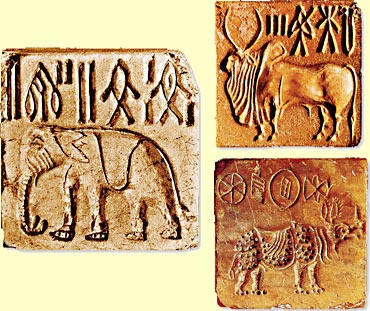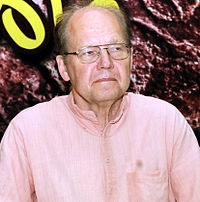
Tamil language, a repository to reconstruct Indus Valley Civilisation: Top Indologist

India’s earliest urban culture (2600 until 1900 BCE) was discovered in the valley of the Indus river in 1920. With an estimated population of one million, the people in the Indus Valley civilisation lived in 1,000 settlements, and several of them were cities and towns like Harappa and Mohenjo-daro.
The cities showed a great brilliance in water management and town-planning but it seems the IVC people didn’t waste money constructing temples and palaces the way people in other ancient civilisations like the Mesopotamian and Egyptian did.
The IVC scripts which were discovered in 1921 and however still remain undeciphered even after 100 years. However, the Middle Eastern scripts like Egyptian, Sumerian and Akkadian have been deciphered with certainty.
What language did the Indus people speak? Asko Parpola, who has been studying the IVC script and seals for the last five decades, is still trying to find an answer to the question.
“The Indus script is logo-syllabic. The high age of the creation of the script is between 2800-2500 BC. There are 400 graphemes and the short word length normally is one to three signs. Larger sequences consist of short words. The pictorial meanings change depending on the context, making deciphering difficult,” said Parpola, a renowned Indologist, who is currently professor emeritus of Indology and South Asian studies at the University of Helsinki, Finland.
Tamil has its roots in the Indus Valley Civilisation
Tamil is considered one of the oldest spoken languages in the world and is believed to have its roots in the IVC. According to Parpola, there are 26 Dravidian languages today.
“I think Tamil is the only one among these Dravidian languages which preserved many astronomical terms from IVC. So, Tamil in many respects is the most viable archive and a repository to reconstruct the IVC,” pointed out Parpola.
Also read: Did the Indus Valley civilisation speak an ancient form of Tamil?
There are many Dravidian loanwords in Rigvedic Indo-Aryan (1200 BC), added Parpola, speaking on “Dravidian and Indus Valley Script” at an event organised by the Centre for Singapore Tamil Culture recently. Dravidian loanwords such as ‘mukham’ (face, front, mouth), ‘khalam’ (threshing floor), ‘phalam’ (fruit) and ‘kundam’ (pit) are found in the Rigvedic Indo-Aryan texts.
Old Tamil god “Muruku” (baby boy), according to Parpola, is a hunter god of the hill forests. Muruku, the god of love and fertility, was worshipped with frenzy dances and flesh and blood of a ram or goat. In 300 CE, the god amalgamated with Skanda of north India. “The pictorial and rebus meaning of fish in Dravidian means ‘miin’ and ‘miin’ also means star. I think they both possibly come from ‘min’ which means ‘to glitter’,” suggested Parpola.

Parpola’s interest in the Indus Civilisation
In 1959, Parpola went to the University of Helsinki to study ancient Greek language and literature but later switched to Sanskrit and comparative Indo-European linguistics. His teacher suggested he study the “Drahyayana-Srautasutra”, which deals with the duties of the chanter priests in Vedic rituals.
In search of the manuscript of the ancient text, Parpola first visited India in 1971. He started learning more about the Vedic rituals. In 1975, he got an opportunity to witness the entire performance of a Vedic ‘Soma’ sacrifice. It was his wish to understand better the formation of Hinduism that encouraged his initial interest in the Indus Civilization.
However, the encouragement to study the Indus script came from Seppo Koskenniemi, a childhood friend, who had worked as a scientific advisor to IBM in Finland in the mid-1960s. Seppo told Parpola that if he wanted to use a computer for his PhD, he could use IBM’s facilities. Unlike today, the computer was a new technique then. For Parpola, reading John Chadwick’s famous book titled The decipherment of Linear B (1958) was a turning point.
Seppo and Parpola together took up the decipherment of the Indus script as a hobby. Parpola’s younger brother, Simo, also joined them. The computer was handy for the team to work on the Indus scripts. It has been more than five decades now and many developments later, they are still on the journey.
Also read: Was Indus civilisation really a part of Vedic culture?
In Search of Indus Seals
The first Indus seal was discovered in 1875 before the discovery of the IVC in 1920. There have been many attempts to decipher the Indus script since then but no one could do it. Elaborating on the team’s initial challenges, Paropla said that are many obstacles to deciphering the Indus script.
“First, there was no translation to the known languages like how the Rosetta Stone opened a solution to the Egyptian Hieroglyphs. Many signs in Indus seals which depict fish, Sumerian economic texts record rations of fish but Mesopotamian seal texts do not mention fish. The surviving text was very short as well and the pictorial signs are difficult to recognise,” he explained.
So, they went about the task to assemble all the known Indus inscriptions. He visited the museums in India and Pakistan in 1971 in search of Indus seals. “I discovered hundreds of Indus seals that have never been published. This prompted me to start the project of publishing all known Indus seals and inscriptions,” said Parpola, who has published four volumes and two more are on the anvil.
Deciphering signs and faunal remains
The next task was to prepare a computerised edition that would enable the team to process concurrence in which all the occurrences of every sign would have been sorted based on their context. This made the analysis of the inscriptions easier for the team. “There were 400 signs with variations. The challenge was that some symbols found in the early Harappan post were absent from the Indus script. The star symbol was one. The early Harappan pots had it but the symbol was absent from the Indus script,” he said.
Speaking on the faunal remains in the great Indus Valley, Parpola said the horse and donkey came to the region after 2000 BCE. “The first evidence of the horse-drawn war chariot was recorded in Sintashta in the Ural steppes during 2000-1900 BCE. It means that the proto Indo Aryan started coming towards today’s India only around 1900 BCE and the archaeological evidence suggest that they actually came to the borders of Pakistan and India around 1500 BCE,” said Parpola, who is the author of Deciphering the Indus Text and The Roots of Hinduism.
It was during 2000-1900 BCE that the IVC came to an end. Multiple causes, said Parpola, have been given for the gradual decline and eventual downfall of urban life in the Indus valley, which resulted in the disappearance of the Indus script and seals. “The latest samples of the Indus script are from the southernmost site of Daimabad, not too far from Mumbai, about 1800 BCE,” he said.
Natural calamities, like floods and earthquakes, and rivers such as Indus and Ghaggar-Hakra changing their course are the reasons behind the fall of IVC. “Apparently, all this coincided with the arrival of the first wave of Indo-Aryan speakers in South Asia. But there is no evidence of a massacre of Indus valley populations by “Indra’s hordes”, as was once believed. Rather, the skeletons lying unburied in the streets of Mohenjo-daro are now known to have belonged to people who died from malaria and cholera, not armed assault,” said Parpola.
Asked whether young scholars will continue the research that he has been doing for the last five decades, Parpola said, “I have no one to follow in my footsteps. But there will be people interested in continuing the work with time. The researchers of Dravidian studies must take a proper position when it comes to Indological research. Unfortunately, classical Indology is taking a backseat in many countries today. Importance is given to ‘modern’ subjects only,” he said.

